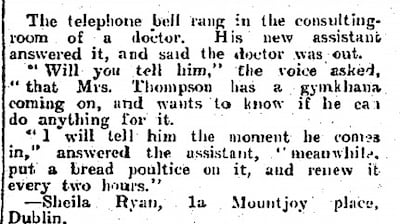Though practiced for thousands of years, the use of poultices in general medicine fell out of favour before this publication had reached its centenary.

A poultice is a moist concoction – usually heated – spread on an injury, ache or wound, and held in place with a cloth. It was sometimes known as a “plaster” when the poultice was smeared on a bandage before application.
The most popular seem to have been made of bread, linseed, or mustard mixed with water. The use of bran, flour and starch was also common, and medical preparations, or herbs such as comfrey and horseradish root, were often added to the mix.
The Irish Times’ household hints column in 1885 recommended that “a pound or so of coarsely-crushed linseed should always be kept in the house in an airtight tin, also a tin of mustard and camomile flowers and poppy heads for poultices and fomentations”.
Poultices were believed to “draw out” inflammation and infection. They were prepared for a range of complaints including boils, toothaches, bunions, abscesses, splinters, chilblains and styes. Even the treatment of serious illnesses, such as TB and cholera, often involved some form of poultice being administered to the patient. Both doctors and nurses were trained in how to make and apply them.
They were viewed as essential when treating colds, congestion or any sickness of the lungs. Instructions, published in 1912, for home nursing patients with bronchitis and pneumonia specified: “Poultices must be applied where pain is felt, which is most usually in the back, but may require to be put on both back on front. They must be really hot, though not sufficient to blister the patient . . . ”
‘Most efficacious’
Poultices were almost a disregarded treatment in 1930 when "A Woman Doctor" reminded Irish Times readers of their value in an article on How to Gain and Retain Good Health: "The poultice is not very commonly used now, but is good for checking an incipient chest or throat cold, and also for relieving acute indigestion. Made of linseed meal and mustard (generally three parts of the former to one of the latter) and put between two layers of flannel, it is most efficacious, since it can be placed against the skin when very hot and so retain its heat longer. Carry the poultice to the patient between two plates which have been thoroughly warmed.

“Another idea is to take equal parts of mustard and ordinary household flour, work these into a paste with tepid water (hot water takes much of the virtue out of the mustard). Spread the paste thickly on brown paper, and cover with gauze, turning up the paper edges all round to keep it in place. If a more drastic mustard “leaf” is required, reduce the quantity of flour or omit it altogether. Ten to fifteen minutes is the usual time for this poultice to be applied to the skin, and when it is removed a little olive oil should be applied.”
Hot linseed poultices were also recommended for ingrown toenails, swellings, cramps and insect stings, and to draw out pus and poisons. Suggested additions to the linseed mush included glycerine to make it “more soothing”, or “a little mustard” to soothe stomach cramps. Boils and lumps were to be poulticed with very hot linseed meal and turpentine, or resin ointment, until they burst; then washed out and dressed.
Another favourite application was wet bread. “If a soft corn is inflamed it must be poulticed with a little bread and water at night, reader “Pansy” was told in 1904. One “household hint” for neuralgia in 1922 was: “Apply an ordinary bread poultice, as hot as can be borne, to the affected parts.”
Dog bite
The antiseptic boric acid was often added onto bread poultices. One reader was prescribed this combination following a dog bite, another to reduce inflammation in a child’s arm after a vaccination.
The pain may be relieved by applying hot poultices, if possible, sprinkled with laudanum
Other common household ingredients were also employed. A sore throat could be poulticed with onions, or “the mealy part of roasted potatoes spread on flannel, and placed on the throat as hot as could be borne”. Readers in 1916 were told “a poultice made of raw potatoes finely scraped and saturated with cold-drawn linseed oil” could be applied to burns and scalds, “if the skin is broken”. Cold water and oatmeal were also recommended: “The cooling properties of the oatmeal help to draw the fire from the burn, whilst its soothing properties heal it.”
The heat of a poultice was used to relieve pain, sometimes with assistance from pharmaceutical ingredients. Advice in 1909 for lumbago included: “When a bad attack comes on there is nothing for it but to keep warm in bed, and the pain may be relieved by applying hot poultices, if possible, sprinkled with laudanum.”
In 1923 came less-addictive solutions for aches and pains: “a bag of hot salt” or “a vinegar and bran poultice . . . made by moistening bran with vinegar and heating it”.

A “Women at Home” page in 1934 contained two poultices for “obstinate skin trouble”: one made by mixing powdered starch and boracic powder with hot water, and the other by sprinkling a layer of powdered charcoal on a linseed or bread poultice. A similar starch poultice was recommended in 1903 for removing scabs from the head before applying ointment, while “Annette” was told to put a starch poultice made with bran water on painful sunburn in 1905.
Ship’s biscuits
Some ingredients were even more unusual. A memoir by Navy admiral Reginald Bacon, published in 1925, told of one crew, injured in pursuit of a slavers vessel, who had been reduced to “poulticing the wounds of those who survived with ship’s biscuits, soaked in cocoa, bandaged on with strips torn from such clothing as they could spare”.
Poultice and plasters could also feature sinister components. The use of arsenic for skin cancers was a prevalent "quack" treatment. An inquest report from Enniscorthy in 1859 recounted how weaver Redmond Kavanagh had died from arsenic externally applied in a "cancer plaster". "The usual symptoms of poisoning set in. The plaster was taken off and thrown into the fire, and the part affected poulticed with barley and linseed meal."
As the 20th century brought many medical advances – and the commercial availability of less-homespun options – even previously approved poultice treatments fell out of favour among medical professionals.
Their gradual loss of appeal to the public, meanwhile, may have been aided by the intensive promotional campaign launched in the late 1920s by Vicks VapoRub, which pitched itself as the “modern” alternative to the “old-fashioned poultice”.
- This is part of a series looking at the archives of The Irish Times concerning health.
1) Sleeping secrets: undress in the dark
2) Cooking for invalids: wine and champagne
3) Eat fat, no milk: 19 rules of long living
4) Bloody cures for women's periods
5) Electrical cures to revive sluggish functions
6) Your 'flatulence' explain your 'noises'
7) Curing psoriasis with nude sunbathing
8) Weight-loss: Obesity soap and fat massage
9) Institution Dubliners hoped they'd never enter
10) Cocaine Tooth Powder
11) 'Sun-ray' therapy
12) Men's hair products
13) A history of Irish lunacy
14) Prescribing clothes for women's health
15) Most unhealthy of any great Irish towns
















